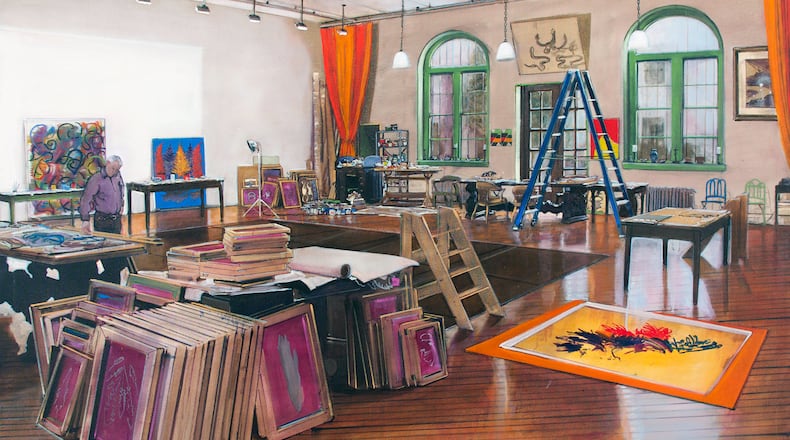If you relish a behind-the-scenes look at the creative process–whether it’s “Chef’s Table” or “Project Runway”– you’ll relate to Joe Fig.
Fig, whose artwork is currently featured in a Focus exhibit at the Dayton Art Institute through Jan. 1, is intrigued by visual artists and their process. He’s best-known for his detailed renditions of real artists’ studios, created on a one-inch to one-foot scale. Anyone who loves miniatures and dollhouses will appreciate these “sculpturamas” and the whole family will have fun discussing them.
“Joe Fig: Other Artists” is being presented in conjunction with the DAI’s special exhibition, “American Myth & Memory: David Levinthal Photographs.”
What Levinthal and Fig have in common is that both are photographers who enjoy creating and shooting miniature scenes. In the case of Levinthal, the subject matter is toys; in the case of Fig, it is intricate recreations of artists’ studios which he designs, builds and then often photographs and paints.
The multi-talented Fig, who lives in Sarasota, Florida, is the department chair of Fine Arts and Visual Studies at Ringling College of Art and Design and the author of “Inside the Painter’s Studio” and “Inside the Artist’s Studio.”
“I like labor-intensive work,” says Fig, who adds he’s fascinated by artists’ studios and how artists work in their studios. “We go to museums and galleries and see the finished product on the walls where they are perfectly lit and placed, like my show is in Dayton,” he explains.” But it’s really inside the studio where art is being made and where the artist works the most. I find that most interesting, like when you see how a musician crafted a song or how a writer writes their novels. It isn’t just about the final piece, there are a lot of other parts that get them to that point.”
In addition to studying historical studios of famous artists who are no longer living, Fig has visited, interviewed and photographed living artists in their workspaces as well. He tells them not to clean up their studios before his visit.
“I want it to look as if you just left to get a cup of coffee,” he instructs. “I want it to be authentic and I just want to be a fly on the wall.”
Later, when he gets back to his own studio space, he begins creating small sculptures that capture what he’s experienced.
“I think we’ve always been interested in artists’ lives and studios but it’s only been in the past 25 years or so that their studios have been a little more accessible,” says the DAI’s chief curator Jerry Smith. “No two studios are alike. They end up being a portrait of the individual.”
Coming to Dayton
Smith will never forget the moment he first encountered Fig’s unusual work. He was in Cincinnati at the time, marveling at Ronnie and John Shore’s extensive modern and contemporary art collection. The Shores have been acquiring art since they married 62 years ago. Every few years they host dinner parties for museum folks in our region.
When Smith first saw Fig’s version of artist Jackson Pollock’s studio, he began to laugh. “It was a joyful laughter because I was absolutely delighted!” Smith remembers. “I was so shocked and surprised by it.”
That amazing recreation of Pollack’s paint-splattered barn is now delighting DAI visitors. The Shores have generously loaned pieces from their Fig collection to the Dayton exhibit. There is artwork from James F. Dicke Family Collection on loan as well.
Ronnie Shore says she marvels at the intricate work that goes into Fig’s creations. “I’m intrigued with the little paint cans in the studio that are as big as my little fingernails,” she says. Fig says the paint tubes are made out of clay and rolled like spaghetti, then hand-painted. When he constructs a tiny table, Fig says, he puts it together the same way he’d make a bigger table.
Ronnie Shore says she’s always amazed by the photos that Fig takes of the studio sculptures he has created. The first time she saw one of those photos, she thought it was a picture of a real studio. “Many people who come through our spaces think they are real photographs,” she says. “But they are actually photos of his dioramas!”
Fig says he’s not trying to fool viewers into believing the figures in the studios are real people. “My intent is that when you look at them you’ll see that something is off,” he explains. “I do want them to think it’s a believable scene at first.”
The photos of the miniature studio are often displayed next to the model. " Ideally, if you show the sculpture with the photo, you can look and reference photographs and sometimes see things because of the photograph that you might not see otherwise,” Fig says. “And even though I’m making sculptures, I see more like a painter than a sculptor. Sculptors see the world in three-dimensional form. For me, when I take a photo it’s a way to bring the three-dimensional form back to a more two-dimensional form.”
Other parts of the exhibit
In addition to the studio sculptures and photos, the DAI show includes other aspects of Fig’s work, including paintings of a number of artists’ palettes.
“I see the palette as a form of portraiture,” Fig explains. “The marks on the palette are almost like someone’s personal signature, they show the way a person works.”
Some palettes of famous artists have been preserved for years; others can be seen in images in historical books. Fig sometimes asks living artists who use disposable palettes if he can have them before they’re discarded. He says the way artists make marks and mix their paints on the palette is reflected in their art. “The way each person marks their palette is unique to them,” he says.” Artist Chuck Close, for example, makes circular motions when he mixes colors. "
It’s no surprise that Fig often asks artists if he can have one of their paint brushes. As a result, he has 150 brushes displayed on his own wall.
Fig, who has an identical twin brother, says his parents weren’t especially creative but that he and his brother were always in advanced art classes.
“We drew football players and baseball players, so it never seemed like a special talent but looking back I do feel like my ability came from someplace,” he says. “I was probably born with a lot of it. I never pushed art on my own kids.”
When he interviews other artists, he always asks them to describe an early artwork they made that received recognition. “For me it was a teepee I made in nursery school with Indians on the back wall. I got praise for that. But it wasn’t until I went to college in New York that I was exposed to broader painting and drawing.”
Even more
The DAI show also includes other Fig paintings, some that have been inspired by films about famous artists, others that capture museum patrons gazing at art.
“I look for moments in a film that relate to an artist at work,” he notes. “Then I take a single shot and adjust it.” When he visits museums and galleries, he photographs patrons looking at the artwork, then later turns those photos into paintings.
Ronnie Shore says Joe Fig’s work always brings delight, the same kind of delight Jerry Smith first expressed when he was introduced to Fig’s work at the Shores.
“Everyone who comes to see our art gets a smile on their face,” says Ronnie Shore. " It makes people happy.”
How To Go:
What: “Joe Fig: Other Artists”
Where: Dayton Art Institute, 456 Belmonte Park North, Dayton
When: Through Jan. 15. The museum is open from 11 a.m. to 5 p.m. Wednesday; 11 a.m. to 8 p.m. Thursday; 11 a.m. to 5 p.m. Friday and Saturday and noon to 5 p.m. on Sunday.
Admission: Adults: $15; Seniors (60+), Active Military, Groups (10 or more): $10; College Students (18+ with ID) & Youth (ages 7-17): $5 Children ages 6 and younger and Museum Members: Free
Related programs:
- An artist talk by Joe Fig is slated for 3-4 p.m. on Saturday, Jan. 14. For information on how to register contact Guest Services Desk at GSD_Requests@daytonart.org
- To see a recap of the exhibit: https://youtu.be/nB33QfsQo6M
For more information: www.daytonartinstitute.org/visit or call (937) -223-4ART (4278). Connect with the Dayton Art Institute on Facebook, Twitter, Instagram, TikTok and YouTube for additional information, behind-the-scenes photos and videos, and exclusive offers.
About the Author







